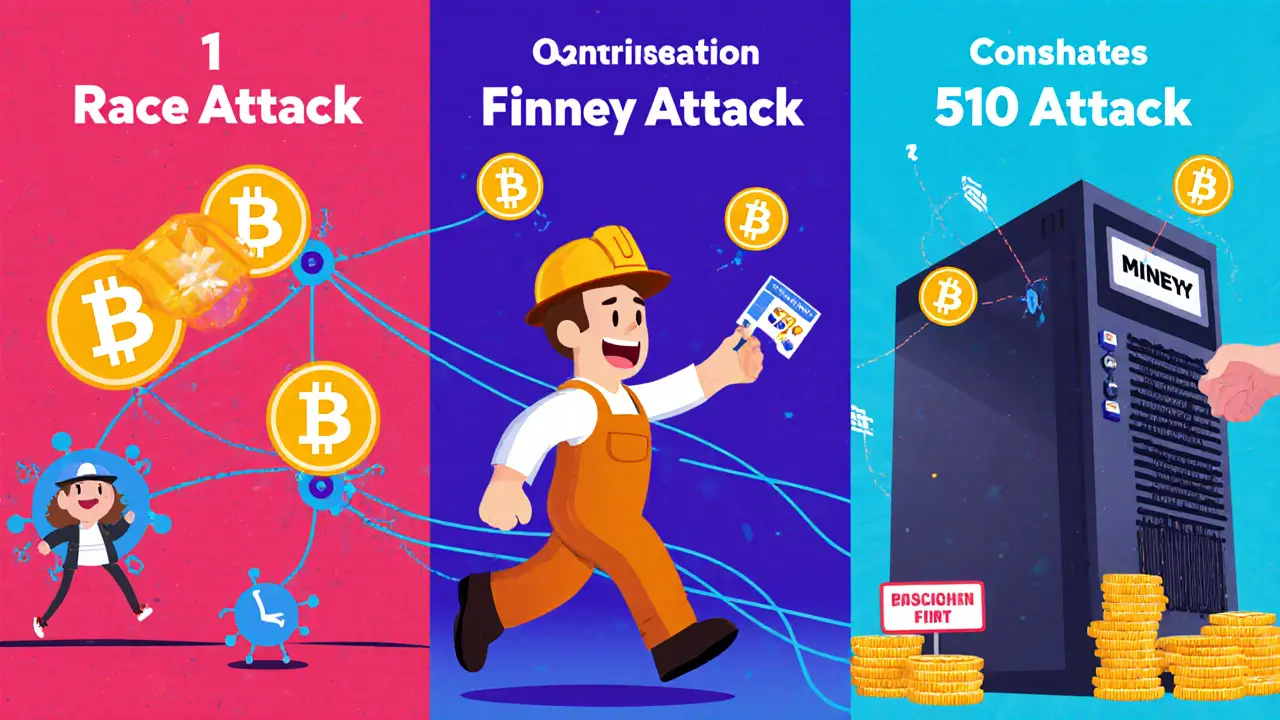Double-Spending Protection Calculator
Transaction Security Calculator
Calculate the recommended number of blockchain confirmations needed for your transaction based on value, cryptocurrency type, and risk tolerance.
Recommended Security Configuration
Important: This calculator is based on industry standards from the article. Always consider network conditions and your specific security needs.
Ever wondered how a digital coin could be spent twice? That’s the crux of the double-spending problem-a flaw that threatens every cryptocurrency. Below we break down the most common attack methods, how they work, and what you can do to stay safe.
What Is Double-Spending?
Double-Spending Attack is a security breach where the same digital token is submitted in multiple transactions, effectively creating money out of thin air. Unlike a physical bill that can’t be in two places at once, digital data can be copied endlessly, so a robust protocol is needed to enforce scarcity.
The solution came with Blockchain technology, which records every transaction in an immutable, time‑ordered ledger. Consensus rules, cryptographic signatures, and network confirmations together make it exceedingly hard to pull off a successful double‑spend.
Main Attack Vectors
Attackers exploit timing gaps, network latency, or sheer computational power. Below are the three classic methods still relevant in 2025.
Race Attack
A race attack is the simplest form. The attacker creates two conflicting transactions and sends each to different subsets of nodes at the same time. If the merchant accepts the first transaction before the network fully propagates the second, the attacker can later broadcast the conflicting one, hoping it gets confirmed while the first remains orphaned.
This method relies on low confirmation thresholds. For low‑value purchases, merchants sometimes accept zero‑confirmation payments, which opens the door to race attacks.
Finney Attack
Named after Bitcoin pioneer Hal Finney, this technique requires the attacker to pre‑mine a block that contains a transaction spending the same coins they intend to use elsewhere. The attacker then makes a purchase, broadcasting the conflicting transaction to the merchant. When the pre‑mined block later propagates, it invalidates the merchant’s transaction.
Finney attacks need significant hash power and precise timing, making them harder than race attacks but still feasible on small networks.
51% Attack
When an entity controls more than half of a network’s total computational power, it can rewrite history. By inserting a private chain that excludes a target transaction, the attacker forces the network to adopt the longer, attacker‑controlled chain, effectively double‑spending the already‑confirmed coins.
On Bitcoin, a 51% attack would cost billions, but on lower‑hash‑rate altcoins-such as Ethereum Classic, Bitcoin Gold, or Vertcoin-it can be economically viable.
How Consensus Mechanisms Defend Against Attacks
Proof‑of‑Work (PoW) and Proof‑of‑Stake (PoS) each add layers of defense.
Proof-of-Work requires miners to solve cryptographic puzzles; each additional block added to the chain increases the cost of rewriting history exponentially. That’s why Bitcoin recommends six confirmations for high‑value transfers-each confirmation adds ~10 minutes of PoW work.
Proof-of-Stake ties validation power to the amount of cryptocurrency a validator locks up as collateral. To successfully double‑spend, an attacker would need to own a majority of the staked supply, which is economically prohibitive for large networks.
Both mechanisms rely on economic disincentives: the cost of attacking outweighs the potential gain, keeping honest behavior profitable.

Real‑World Cases and Lessons Learned
Smaller blockchains have suffered successful double‑spends. In 2022, Ethereum Classic experienced a 51% attack that reversed several thousand dollars worth of transactions. Bitcoin Gold faced a similar breach in 2023, exploiting its modest hash rate.
These incidents underline two key takeaways:
- Never trust zero‑confirmation payments on low‑hash‑rate networks.
- Monitor network hash rates and adjust confirmation requirements accordingly.
On the other hand, Bitcoin’s massive 400 EH/s hash rate in 2024 makes a 51% attack virtually impossible-highlighting how network size directly boosts security.
Prevention Best Practices for Merchants and Users
While the protocol does a lot of heavy lifting, human safeguards add a crucial buffer.
- Wait for sufficient confirmations. Six for Bitcoin, three for most altcoins, but adjust based on risk tolerance.
- Use payment processors that flag suspicious patterns and enforce mandatory confirmation windows.
- Consider Layer‑2 solutions like the Lightning Network for fast, low‑risk payments-though they bring their own set of security considerations.
- Implement transaction monitoring services that can detect rapid rebroadcasts typical of race attacks.
Emerging Trends and Future Outlook
Researchers are eyeing quantum‑resistant signatures to protect against future breakthroughs that could undermine current cryptography. Meanwhile, newer consensus algorithms-such as Ethereum’s Proof‑of‑Stake and hybrid models-aim to retain double‑spending resistance while lowering energy consumption.
Network monitoring tools are becoming smarter, using machine‑learning to spot abnormal propagation delays that may signal an ongoing attack. As blockchain ecosystems mature, the blend of robust protocol design and vigilant operational practices will keep the double-spending threat at bay.
Quick Comparison of Attack Methods
| Method | Required Resources | Typical Targets | Difficulty (2025) |
|---|---|---|---|
| Race Attack | Low - just two conflicting transactions | Zero‑confirmation merchants | Easy on low‑latency networks |
| Finney Attack | Moderate - mining a block in advance | Networks with low block time | Medium - needs timing skill |
| 51% Attack | Very high - >50% of hash power or stake | Small‑hash‑rate altcoins | Hard on major chains, easier on niche ones |
Frequently Asked Questions
Can a double‑spending attack succeed on Bitcoin?
In theory, yes-through a 51% attack-but the colossal hash rate makes it economically impractical. Most real‑world attacks target smaller networks.
What’s the difference between a race attack and a Finney attack?
A race attack broadcasts two transactions simultaneously to different nodes. A Finney attack pre‑mines a conflicting block, then spends the same coins before that block propagates.
How many confirmations are safe for a $1,000 Bitcoin purchase?
Six confirmations are the industry standard for high‑value transactions. Some merchants accept three if they use additional fraud‑detection tools.
Do proof‑of‑stake chains eliminate double‑spending?
PoS reduces the likelihood of 51% attacks by tying influence to token ownership, but race and Finney attacks can still affect any chain that allows zero‑confirmation spending.
Is the Lightning Network immune to double‑spending?
Lightning uses commitment transactions and hash‑timelocked contracts that make double‑spending extremely hard, but users must trust the node operators and keep channels funded.

BRIAN NDUNG'U
June 3, 2025 AT 01:44Understanding how double‑spending attacks function is essential for anyone handling digital assets.
These methods exploit the inherent replicability of data, and the blockchain’s consensus rules are the primary defence.
Merchants should be aware that accepting zero‑confirmation payments creates a window for race attacks.
Implementing a minimum confirmation threshold based on transaction value greatly reduces exposure.
By staying informed and adjusting security practices, participants can help preserve the integrity of the network.
Donnie Bolena
June 9, 2025 AT 05:44Wow!! This post really breaks down the scary side of double‑spending!! 🚀!! Knowing the difference between a race attack and a 51% attack can save you big time!! Keep those confirmations high and the bad guys out!!
Elizabeth Chatwood
June 15, 2025 AT 09:44i love how this explains the Finney attack its super clear and easy to follow
Tom Grimes
June 21, 2025 AT 13:44I remember the first time I heard about a double‑spending attempt, it felt like something out of a cyber‑crime movie.
Back then I was just a hobbyist miner, and the idea that someone could trick a merchant by sending two conflicting transactions made my head spin.
The race attack is the simplest, and it works because the network needs time to propagate each transaction to every node.
If a shopkeeper accepts a payment before the second transaction spreads, the attacker can later push the conflicting one and hope it gets confirmed.
I tried to test this on a testnet once, sending one payment to a friend and another to a fake vendor, just to see which would win.
The network latency was the deciding factor, and the transaction that reached the majority of peers first was the one that stuck.
When I moved on to learning about Finney attacks, I realized they require pre‑mining a block that already contains the spend.
That meant you need not only hash power but also perfect timing to release the block after making the purchase.
I once saw a forum post where someone claimed to have pulled a Finney attack on a small altcoin, but they never posted proof.
The 51% attack, on the other hand, feels like the ultimate power play because it can rewrite history if you control the majority of the network’s work.
While it’s practically impossible on Bitcoin today, smaller chains can still fall victim if an entity gathers enough hash power.
What scares me most is how quickly these methods can evolve, especially when new consensus mechanisms are introduced.
Proof‑of‑Stake adds a different twist, tying the ability to validate blocks to the amount of stake you hold.
If a validator accumulates a majority of the stake, they could theoretically double‑spend by creating a fork that favors their own transactions.
That’s why many projects are now adding slashing penalties to discourage such behaviour.
In the end, the safest approach for anyone using crypto is to wait for enough confirmations, use reputable payment processors, and stay updated on network statistics.
Paul Barnes
June 27, 2025 AT 17:44While many panic over 51% attacks, the real risk often lies in human error and poor operational policies.
John Lee
July 3, 2025 AT 21:44Think of the blockchain as a bustling city; every transaction is a courier delivering a package, and confirmations are the traffic lights that keep the streets orderly.
When those lights turn red too soon, chaos can spill over, letting a sneaky courier slip by with a duplicate parcel.
By adjusting the timing of those lights to match the city’s traffic flow, merchants can keep the streets safe and the packages unique.
Jireh Edemeka
July 10, 2025 AT 01:44Oh great, another reminder that zero‑confirmation payments are basically an invitation for hackers – who could have guessed that trusting strangers on the internet without verification might be risky?
del allen
July 16, 2025 AT 05:44i totally get it, double‑spending is like that friend who keeps borrowing your stuff and then pretends they never got it 😂👍
Jon Miller
July 22, 2025 AT 09:44The moment you think you’re safe, the blockchain whispers, “Did you really think a single confirmation was enough?” and the shadows of race attacks loom, reminding us that every transaction carries a hidden drama.
Rebecca Kurz
July 28, 2025 AT 13:44Notice how the article emphasizes confirmations!!! It’s not just a suggestion; it’s a shield!!! Without enough confirmations, you’re practically handing the attacker a golden ticket!!!
Nikhil Chakravarthi Darapu
August 3, 2025 AT 17:44India’s burgeoning blockchain ecosystem must adopt stringent confirmation policies to protect its citizens from double‑spending threats and preserve the nation's financial sovereignty.
Tiffany Amspacher
August 9, 2025 AT 21:44In the grand theater of decentralised finance, each block is a fleeting act, and a double‑spending attempt is the tragic flaw that reminds us of humanity’s endless quest for control over illusion.
Lindsey Bird
August 16, 2025 AT 01:44Beware the silent double‑spend.